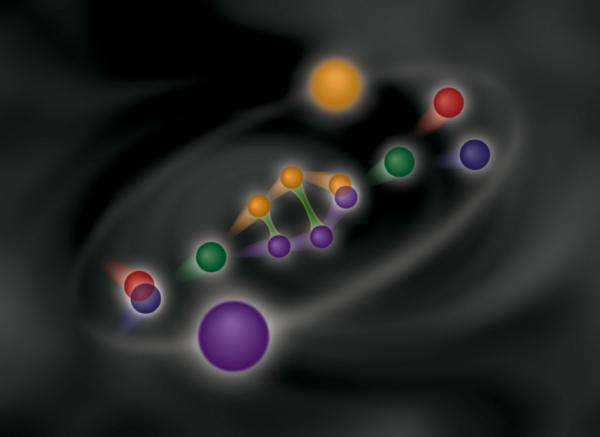But it might be observed even in current collider experiments, according to theoretical work published recently by researchers at the SLAC National Accelerator Laboratory and Arizona State University.
In a paper published May 26 in Physical Review Letters, SLAC theorist Stanley Brodsky and Arizona State's Richard Lebed describe two methods by which electron-positron accelerators could detect the signature of true muonium's formation and decay.

Visualization of how experimentalists could create true muonium, an electron (blue) and a positron (red) collide, producing a virtual photon (green) and then a muonium atom, made of a muon (small yellow) and an anti-muon (small purple). The muonium atom then decays back into a virtual photon and then a positron and an electron. Overlaying this process is a figure indicating the structure of the muonium atom: one muon (large yellow) and one anti-muon (large purple). Graphic: Terry Anderson/SLAC
In the first method, an accelerator's electron and positron beams are arranged to merge, crossing at a glancing angle. Such a collision would produce a single photon, which would then transform into a single true muonium atom that would be thrown clear of the other particle debris. Because the newly created true muonium atoms would be traveling so fast that the laws of relativity govern, they would decay much slower than they would otherwise, making detection easier.
In the second method, the electron and positron beams collide head-on, producing a true muonium atom and a photon, tangled up in a cloud of particle debris. Yet simply by recoiling against each other, the true muonium and the photon would push one another out of the debris cloud, creating a unique signature not previously searched for.
"It's very likely that people have already created true muonium in this second way," Brodsky says. "They just haven't detected it."
In their paper, Lebed and Brodsky also describe a possible but more difficult means by which experimentalists could create “true tauonium,” a bound state of a tau lepton and its antiparticle. The tau was first created at SLAC's SPEAR storage ring, a feat for which SLAC physicist Martin Perl received the 1995 Nobel Prize in physics.
“Once you make some of these atoms, you can study their detailed structure using incredibly fast laser pulses,” says Lebed. “It makes for a truly natural interdisciplinary project combining particle physics, atomic physics and cutting-edge optics.”
Brodsky attributes their finding to a confluence of events: various unrelated lectures, conversations and ideas over the years, pieces of which came together suddenly during his conversation with Lebed.
"Once you pull all of the ideas together, you say 'Of course! Why not?' That's the process of science — you try to relate everything new to what you already know, creating logical connections," Brodsky says.
Now that those logical connections are firmly in place, Brodsky says he hopes that one of the world's colliders will perform the experiments he and Lebed describe, asking, "Who doesn't want to see a new form of matter that no one's ever seen before?"
Article: “Production of the Smallest QED Atom: True Muonium (µ+µ-)", Physical Review Letters





Comments